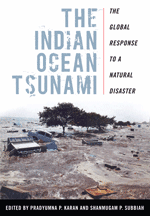Essential reading - Dr Jay Levinson reviews a book on the December 2004 Indian Ocean tsunami
The Indian ocean tsunami – the global response; reviewed by Dr Jay Levinson, Adj. Professor at the John Jay College of Criminal Justice and
Member of Crisis Response Journal's Editorial Advisory Panel

The chapters in this well-edited book give a very comprehensive overview of the 2004 Indian Ocean tsunami and it is clear in reading this publication that disaster responders should have at least a basic understanding of tsunamis and their characteristics (nb this review was written before the March 2011 events in Japan).
From a geological perspective, the Indian Ocean Tsunami was caused by an earthquake (tsunamis can be caused by other earth movements, such as volcanic eruptions). The epicentre was about 160km west of Sumatra, and the focus was about 30km beneath usual sea level. Tsunamis are hard to see with the naked eye, since their force is primarily lower in the sea until they gain their height only as they approach land. Hence, sensors are needed to detect oncoming tsunamis. Movement is multi-factored, depending upon underwater topography, plate movement, land features at the shore, etc.
This tsunami caused damage in several different ways. Most obviously, the height and force of the tsunami waves crushed buildings, drowned inhabitants and washed away signs of life and vegetation. The flow of water back to the sea was also a contributing destructive factor. Salt water deposits affected agricultural land, and in some cases, there was a significant change in topography.
How does one respond? One author cited this not as a disaster, but as a catastrophe in which even the local governments and their emergency plans were devastated by the enormity of damage. There was no choice other than foreign assistance.
There are several points that should be raised. One is that by reading between the lines it is evident that a cultural divide exists between Oriental and Western ideals. Mention is made only of the bodies of deceased tourists that were identified. Otherwise authors spoke of collecting the dead and their burial (curiously, a religious function in one locality, rather than a governmental responsibility).
One author had a very keen insight into response, which he defined as actions in the first 60 hours after an event. He properly contended that relief should start during the response stage rather than subsequently, both because of immediate needs and survey for long-term assistance. Permanent rehabilitation, often thought to start after the response stage, requires extensive planning in a catastrophe and can start only after ‘temporary’ relief has been underway for quite some time (often that temporary relief continues well into the rehabilitation stage).
In many cases immediate response was hindered by poor communication, which complicated reports of need, and transportation routes that were cluttered with debris, if not totally destroyed. In one case cited, damage to an airport runway precluded the arrival of aircraft.
The book deals with lessons learnt, the vast majority of which are well-known from other disasters. Perhaps most blatant of these is that relief assistance is often supply rather than need generated, ie supplies are sent according to availability rather than need. In India, for example, the tsunami waves destroyed thousands of residences. Even though heat often reaches 40°, some organisations supplied metal housing units which absorb the sun’s heat and were totally unusable. As in other cases, there were also supplies with instructions written in languages which the recipients could neither read nor understand. It is clear that often it requires an outsider to record frank lessons learnt, since insiders often shun self-criticism.
One straightforward chapter describes the political element in the decision-making process and the allocation of relief and rehabilitation resources, bringing home the hard fact that absolute need is sometimes shunned in favour of other considerations. And, as ugly as it sounds, where there is money, there can be crime. This point is raised, as is the desperation that can lead to human trafficking with all of its ramifications.
The Indian Ocean Tsunami exacted a tremendous toll which is hard for outsiders to fathom. Families were destroyed leaving large numbers of orphans, widows and widowers. Lifetime savings were wiped out. Yet, positive steps toward reconstruction were sometimes rejected by the population most in need of a secure future. Distancing new residences from the shore line, for example, has complicated the lives of fishermen, who were asked to live far from their places of work.
Not all is negative. It was shown that planning in Thailand saved lives and facilitated response. That planning included public awareness education, designated escape paths, and co-ordinated intra-government communication. Lack of these factors complicated the response in certain other countries, such as Sri Lanka.
Education, refuge and communications are essential and in the Indian Ocean basin where tsunamis are relatively common, this is certainly the way to go. A recent study summarizes that significant tsunamis were felt in 1607 and 1755, and that: “The possibility of significant future events cannot be dismissed.” We must ask ourselves what level of planning is justified.
Much has been written about the Indian Ocean tsunami, and undoubtedly more will be written in the future. Nevertheless, this book offers an important contribution to our understanding of the event.
The Indian Ocean tsunami – the global response, ISBN: 978-0-8131-2652-4, Ed Pradyumna P Karan and Shanmugam P Subbiah, is available from: www.kentuckypress.com
Jay Levinson, 07/09/2011